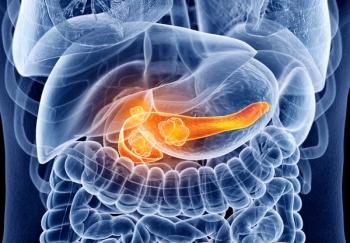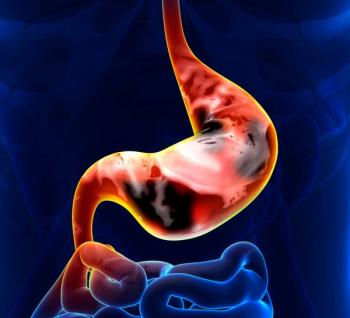
Oncology NEWS International
- Oncology NEWS International Vol 11 No 9
- Volume 11
- Issue 9
Pemetrexed/Gemcitabine Promising in Advanced Pancreatic Cancer
ORLANDO-The combination of pemetrexed (Alimta) and gemcitabine (Gemzar) is active in pancreatic cancer with acceptable toxicity and a promising 32% 1-year survival rate, according to an oral presentation at the 38th Annual Meeting of the American Society of Clinical Oncology (abstract 499).
ORLANDOThe combination of pemetrexed (Alimta) and gemcitabine (Gemzar) is active in pancreatic cancer with acceptable toxicity and a promising 32% 1-year survival rate, according to an oral presentation at the 38th Annual Meeting of the American Society of Clinical Oncology (abstract 499).
Pemetrexed is a multitargeted anti-folate shown to have activity against pancreatic cancer in phase I and II trials. The combination of pemetrexed with gem-citabine is synergistic in vitro and was broadly active in a phase I study.
In this multicenter phase II trial, previously untreated patients with histologically proven advanced pancreatic cancer received gemcitabine, 1,250 mg/m2 over 30 minutes on days 1 and 8 of a 21-day cycle; pemetrexed, 500 mg/m2 over 10 minutes on day 8; and dexamethasone premedication to prevent rash.
Of 42 patients enrolled from September 1999 through November 2000, 41 were evaluable for response after receiving a total of 213 cycles (range, 1 to 20 per patient; median, 4). Median age was 60 years (range, 34 to 79); 64% of patients were male; 95% had stage IV disease; 12% had received prior fluorouracil. Most patients had a Karnofsky performance status of 80 or 90, and 67% had liver metastases.
"Beginning in December of 1999, folic acid and vitamin B12 were also given during a 2- to 7-day lead-in period, since earlier studies showed that these supplements significantly reduce pemetrexed toxicity," said presenter and lead author Hedy L. Kindler, MD, assistant professor of medicine, University of Chicago.
Patients underwent a daily pain assessment and kept an analgesic medication diary; they were seen weekly for history, physical, weight, and performance status, and every 6 weeks they had a CT scan and a CA19-9 test. There were six partial responses for an overall response rate of 12%, and 44% of patients had stable disease. Three additional patients had an unconfirmed partial response. One-year survival was 32%. Median survival was 6.6 months, and median time to progression was 3.1 months.
Clinical benefit analysis was done on 30 patients, and 4 patients (13.3%) achieved a clinical benefit response (a composite of performance status, analgesic consumption, pain intensity, and weight). "It is noteworthy that the patients in this study were less symptomatic at baseline, compared to those in a randomized gemcitabine study, which is why we may have seen a lower clinical benefit response," Dr. Kindler said.
Grade 3-4 hematologic toxicities included neutropenia in 84% of patients, leukopenia in 74%, thrombocytopenia in 33%, anemia in 14%, and neutropenic fever in 12%. Other grade 3-4 toxicities were fatigue in 4% and diarrhea in 2%.
"In general, it appeared to me that this regimen was a step forward over single-agent gemcitabine," coinvestigator Howard Hochster, MD, an oncologist at New York University, told ONI. "The regimen was tolerated well with few additional toxicities, except for some increased fatigue, compared to my experience with gemcitabine as a single agent. Two of my patients responded, including one for more than 6 months with very good quality of life."
An ongoing international randomized phase III trial of pemetrexed/gemcitabine vs gemcitabine alone is currently enrolling patients with a goal of 520. "This study should determine whether the addition of pemetrexed improves survival, response, and quality of life in pancreatic cancer patients," Dr. Kindler said. ONI
Articles in this issue
about 23 years ago
Tumor-Specific Idiotype Vaccines Promising in B-Cell Lymphomasover 23 years ago
Childhood Survivors May Not Know Their Past Rxover 23 years ago
Physician Experience Predicts HIV-Related Mortalityover 23 years ago
Eloxatin With 5-FU/LV Approved for Recurrent Colon Cancerover 23 years ago
Comprehensive Geriatric Evaluations Improve Careover 23 years ago
Nordion’s Monte Carlo Dose Calculation Software Approvedover 23 years ago
No Strong Link Between Breast Cancer Risk and Pollutantsover 23 years ago
Imatinib Inactive in Sarcomas That Lack C-KIT/PDGFover 23 years ago
Task Force Recommends Screening for All Age 50 and OverNewsletter
Stay up to date on recent advances in the multidisciplinary approach to cancer.

















































































